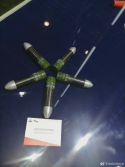Or possibly just mock ups. We have never seen these before or since that parade. The lower portion is clearly a AK74 but the upper body?
It looks a lot like the K11 so much so, I suspect more a dummy. It’s an old doctrine for some Armies SF units to cover themselves as enemy troops and infiltrate behind the lines for sabotage. To do this they often clone uniforms and visually modify vehicles and equipment. The DPRK is said have bought and built clones of American and South Korean small arms.
Do I have evidence of this, No I admit this. Yet it has as much potential as them launching a OICW program. All we have is photos and unless Norinco sold them the tech ( no I am not saying they did). I doubt the DPRK could cook up a airbursting OICW and field them in such numbers. It’s a highly sophisticated technological system. Fielding such should be a bragging point yet this is the DPRK who has shown an exceptionally limited technology base.
===
I don't see this is particularly sophisticated.
For the airburst grenade, you'd need a laser rangefinder and a wire that calculates and communicates the timing to the grenade.
For the OICW capability, you'd need something that can transmit data across devices (gun camera to helmet lens).
The challenge is less doing it, but doing it well. For instance, since this is all electronics based and the computation can be done by an iPhone computer, you can just source stuff from Shenzhen. But is the material going to be reliable and durable? How well would it function under EM jamming?
In the Chinese OICW concept, it seems as though the datalink works for multiple devices, i.e, a commander can get a view from his point man's camera. This, however, is a technically sophisticated concept and requires a network. This, in contrast, is something I doubt the North Koreans would be interested in doing.
Likewise, we have no notion of the OICW weight; the North Koreans, given that the construction looks like a lot of metal and that there's a seeming stress in how the soldiers are carrying it, might have ended up developing a counterpart showpiece system that's very heavy, especially since, unlike the Chinese, they didn't go to bolt-action for weight reduction.
Remember, the American OICW didn't die because it was too technically challenging, it died because it was overweight.










